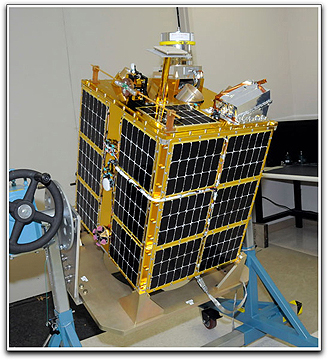NASA has partnered with Dynetics and the Von Braun Center for Science and Innovation, or VCSI, both in Huntsville, Alabama, to successfully complete environmental testing of the Fast, Affordable Science and Technology Satellite, or FASTSAT- HSV01. FASTSAT-HSV01 is a unique platform that can carry multiple small instruments or experiments to low-Earth orbit on a wide range of expendable launch vehicles for a fraction of the cost traditionally required for such missions. The satellite or "bus" will carry six small payloads, including three technology demonstration experiments and three atmospheric research instruments.

The recent environmental tests will ensure before actual flight that the satellite can withstand the rigors of liftoff and the extreme thermal conditions of space. In the past month, engineers at the Marshall Center subjected the spacecraft to the vibration levels of launch, electromagnetic emissions and thermal vacuum conditions of space.
Nanosail D — a technology experiment to demonstrate deployment of a compact solar sail boom system from FASTSAT — will be the first solar sail deployed demonstrating FASTSAT's ability to launch a nanosatellite into space. Nanosail D was built and is managed at the
Marshall Center with support from
NASA's
Ames Research Center in Moffett Field, California. The other two technology experiments include the
Threat Detection System and the
Miniature Star Tracker, both managed by the
Air Force Research Lab at Kirtland Air Force Base, N.M.
In addition, the spacecraft carries three atmospheric instruments built at NASA's
Goddard Space Flight Center in Greenbelt, Md., in partnership with the
U.S. Naval Academy in Annapolis, Maryland. The instruments include the
Thermosphere Temperature Imager, designed to measure spacecraft drag and other flight characteristics; the
MINI-ME, a low-energy neutral atom imager that will detect neutral atoms formed in the plasma population of the Earth's outer atmosphere to improve global space weather prediction; and the
Plasma and Impedence Spectrum Analyzer, a device that will test a new measurement technique for the type and density of thermal electrons in the ionosphere, which can interfere with radio-based communications and navigation.
FASTSAT-HSV01 and all six experiments/instruments flying on the
STP-S26 multi-spacecraft/payload mission have been manifested for launch in 2010 and have been approved by the
U.S. Department of Defense Science and Experiments Review Board. The STP-S26 mission is executed by the
Department of Defense Space Test Program at the
Space Development and Test Wing at
Kirtland Air Force Base, which is a unit of the
Air Force Space and Missile Systems Center. The payloads on the FASTSAT-HSV01 mission are cosponsored by NASA and the Department of Defense.
Topical Tags :
Regional Tags :

